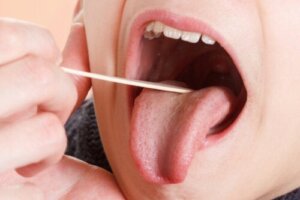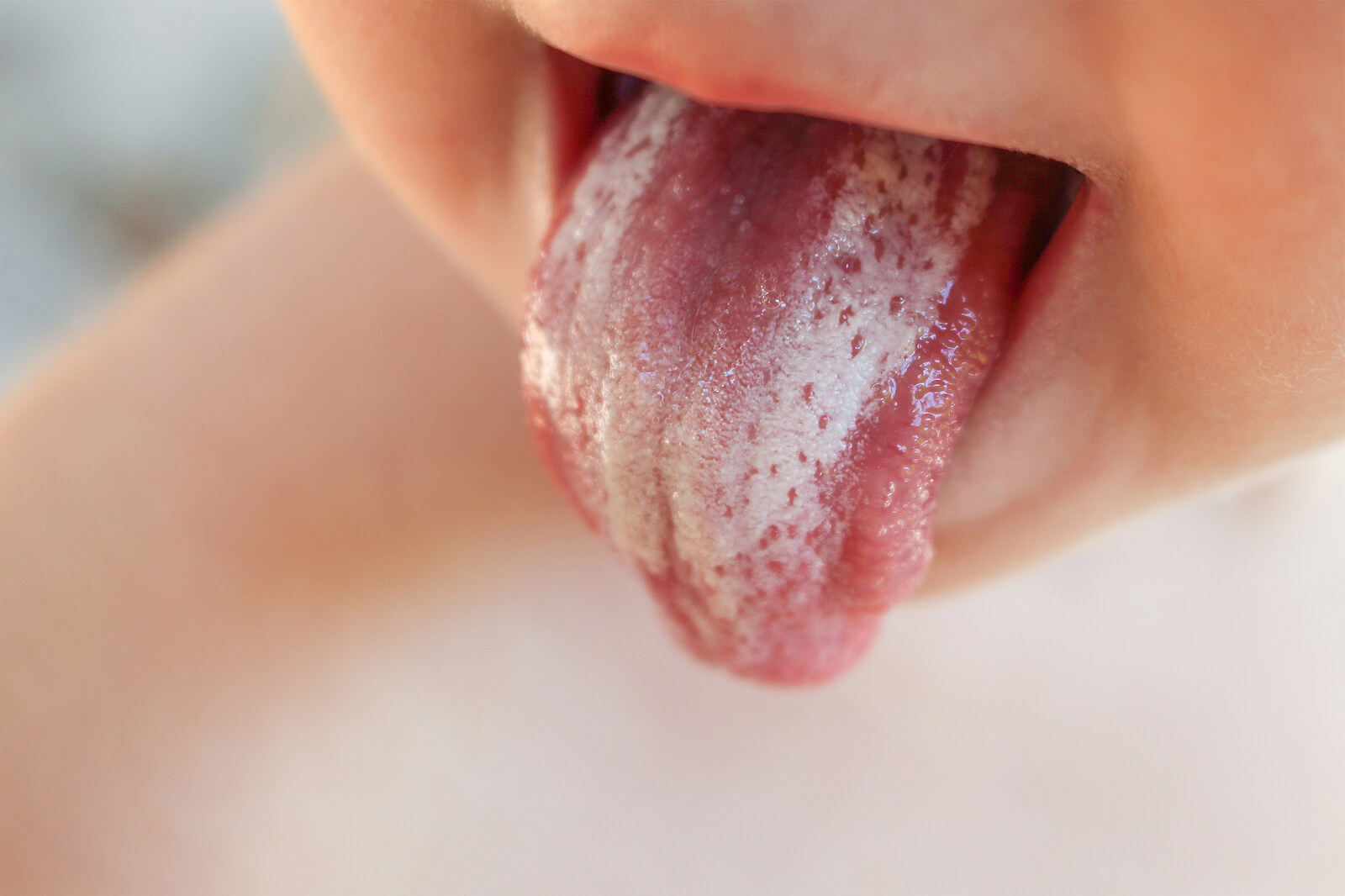White Palate in Children: What It Means and What to Do


Written and verified by the dentist Vanesa Evangelina Buffa
Taking care of children’s health is a real challenge for parents. Finding a white palate in children is a wake-up call and sometimes, this sign is accompanied by discomfort in their mouths.
In this article, we’ll tell you what this problem is and what you should do about it. Keep reading to learn more!
White palate in children
White palate in children is due to a very common fungal infection, especially in babies under 6 months old. This pathology is known as oral candidiasis or thrush.
The fungus that causes it is the yeast candida albicans, which inhabits various parts of the body, such as the digestive tract and the oral cavity. In addition, it easily reaches the mouth of babies through contact with their mother’s saliva or by passing through the birth canal.
In general, the presence of the fungus in the mouth doesn’t cause problems, as the bacteria and the immune system maintain a balance in the flora of the oral cavity.
The problem arises when, for some reason, this balance is broken and the fungus proliferates. This gives rise to thrush.
Candidiasis in the mouth not only causes the palate of children to turn white but also affects other mucous membranes such as the lips, cheeks, and tongue. In some infants, this condition causes discomfort during feeding.
In addition, a baby with thrush can transmit the fungus to the mother’s breasts if breastfed. This may cause discomfort or inconvenience during breastfeeding.

Symptoms of thrush
White palate in children is one of the most characteristic manifestations of thrush. But, as we told you, the roof of the mouth isn’t the only place affected.
The white appearance of thrush on the mucous membranes is very characteristic, as it has the appearance of coagulated milk or yogurt. In addition, when trying to remove these thick plaques with gauze, they don’t come off and remain attached to the affected surface.
Finally, thrush in babies may be accompanied by other signs or symptoms:
- Problems eating: This isn’t always the case, but for some children, thrush causes discomfort when feeding. Especially if the infection spreads to the throat area.
- Cracked skin: If candidiasis develops in the corners of the mouth, it’s often accompanied by cracks and sores.
- Diaper rash: The presence of the fungus in the digestive system leads to it being passed in the stool. This can cause skin irritation in the diaper area.
- Bleeding: Scraping or attempting to remove the whitish plaques from the mucous membranes may cause bleeding in the area. Traumatizing the lesions should be avoided.
- Dysphonia: In more severe cases, the infection may spread to the pharynx and cause aphonia in the child. This becomes evident when the baby cries.
- Injury to the mother’s breasts: If the baby feeds through the breast, the fungus can be transmitted and cause cracked or sore breasts.
Treating white palate in children
The first step in solving the problem of white palate in children is to seek professional help. As soon as you notice any symptoms suggestive of thrush, it’s important to consult your pediatrician. Once the diagnosis is confirmed, the doctor will be able to explain treatment options.
Sometimes thrush goes away on its own within a few weeks. Other times, antifungal treatment, such as gels or topical products on the lesions in the mouth, is necessary.
In addition, the following hygiene measures may also be helpful:
- Properly sterilize pacifiers and baby bottles.
- Clean the nipple and areola after each feeding.
- Change breast pads frequently.
- Keep objects and toys used by the baby clean, especially those put in the mouth.
- Have caregivers and the child wash their hands frequently.
- Wash clothes that have been in contact with the fungus in a washing cycle with hot water above 50 °C.
- If you extract breast milk, keep it frozen until consumption. If it has been contaminated, it should be thrown away.
If the white palate doesn’t disappear after a few weeks of treatment or reappears frequently, it’s best to return to the pediatrician to rule out other health problems.
Can I continue breastfeeding if my baby has thrush?

As we told you, thrush can be present in a baby’s mouth and reach the mother’s breast and vice versa. And the situation can be uncomfortable for both the child and the mother.
For this reason, when it comes to treatment against the infection, it should include both the mother and the baby. In the meantime, it’s important to continue breastfeeding.
Ideally, you should breastfeed for less time, but more frequently. Also, start feedings with the breast that hurts less in order to keep the milk flowing until the infection disappears.
Washing the breasts with clean water after each feeding and letting them air dry promote recovery. If you develop cracks or experience a lot of pain, your doctor may recommend the use of a medication that’s compatible with breastfeeding.
White palate in infants is an uncomfortable situation that involves taking certain steps to help restore the mouth to normal, but it’s not a reason to abandon breastfeeding.
On the contrary, it’s a condition that is easy to resolve. So, if there’s a possibility that your little one has thrush, seek professional help. With simple care, your baby’s mouth will be healthy again.
All cited sources were thoroughly reviewed by our team to ensure their quality, reliability, currency, and validity. The bibliography of this article was considered reliable and of academic or scientific accuracy.
- Cabanillas, D., Pino Araya, C., Finocchi, A., Cañizares, S., Vargas, M. F., & Regairaz, L. (2021). Inmunodeficiencia común variable: manifestaciones clínicas iniciales. Ludovica Pediátrica, 24. https://digital.cic.gba.gob.ar/handle/11746/11128
- Ríos Barja, M. (2018). Conocimientos, actitudes y prácticas del personal de salud de los servicios públicos del municipio de Monteagudo departamento de Chuquisaca con relación a la salud bucal de los niños menores de 5 años (Master’s thesis, Sucre: Universidad Andina Simón Bolívar, Sede Central Sucre). http://repositorio.uasb.edu.bo:8080/handle/54000/794
- González, R. G., Molina, R. B., Rascón, A. N., & Burciaga, R. G. C. (2011). Frequent oral mucosal lesions in children and adolescents: A review of the literature. Revista de la Asociación Dental Mexicana, 68(1), 17-24. https://www.medigraphic.com/cgi-bin/new/resumenI.cgi?IDARTICULO=30781
- Ferreira, C. B., & Andrade, S. (2019). Mastite por Candida em lactante: um relato de caso. Revista Portuguesa de Medicina Geral e Familiar, 35(1), 52-56. https://rpmgf.pt/ojs/index.php/rpmgf/article/view/11907
- Soto Barrera, M. D. P. Prevalencia de patologías bucales en bebés atendidos en el programa de seguimiento del niño de alto riesgo del INMP durante el período enero 2016–diciembre 2017. https://repositorioacademico.upc.edu.pe/handle/10757/625855
- Quesada, J. N., & Córdoba, P. C. L. D. S. Dificultad en el establecimiento de la lactancia materna. https://algoritmos.aepap.org/algoritmo/78/dificultades-en-el-establecimiento-de-la-lactancia-materna
- Castillo-Martínez, N. A., Mouriño-Pérez, R. R., Cornejo-Bravo, J. M., & Gaitán-Cepeda, L. A. (2018). Factores relacionados a candidiasis oral en niños y adolescentes con VIH, caracterización de especies y susceptibilidad antifúngica. Revista chilena de infectología, 35(4), 377-385. https://www.scielo.cl/scielo.php?pid=S0716-10182018000400377&script=sci_arttext&tlng=en
- Arellano Lastra, K. J. (2019). Microbiota oral en recién nacidos por parto vaginal y cesárea en el Hospital Regional Hermilio Valdizán Huánuco 2018. http://repositorio.udh.edu.pe/handle/123456789/2099
- John´s Hopkins Hospital Staff. Muguet (candidiasis oral). John´s Hopkins Hospital Website. Consultado 30 de enero de 2022. https://www.hopkinsallchildrens.org/Patients-Families/Health-Library/HealthDocNew/Muguet-(candidiasis-oral)
- Velasco, L., Mendiola, G., & Pizano, D. (2013). Candidiasis oral en paciente pediátrico sano. Revisión bibliográfica. Revista Oral, 14(44), 956-964. https://www.medigraphic.com/cgi-bin/new/resumen.cgi?IDARTICULO=48169
- Pankhurst C. L. (2013). Candidiasis (oropharyngeal). BMJ clinical evidence, 2013, 1304. https://pubmed.ncbi.nlm.nih.gov/24209593/
- Taylor, M., Brizuela, M., & Raja, A. (2023). Candidiasis oral. StatPearls Publishing. https://www.ncbi.nlm.nih.gov/books/NBK545282/
This text is provided for informational purposes only and does not replace consultation with a professional. If in doubt, consult your specialist.








